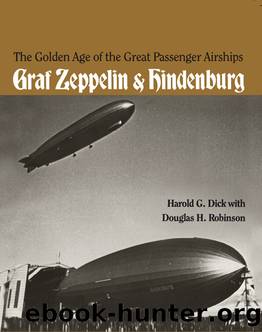The Golden Age of the Great Passenger Airships: Graf Zeppelin and Hindenburg by Harold Dick

Author:Harold Dick [Dick, Harold]
Language: eng
Format: epub
ISBN: 978-1-58834-444-1
Publisher: Smithsonian Books
Published: 2014-12-01T16:00:00+00:00
The takeoff at Frankfurt was normal and the ship proceeded via Cologne to the English Channel. Light winds from the southeast to northwest were encountered during the day but at evening, at about 6 P.M., a front of some intensity was encountered. Winds shifted from southwest, force 3 (8–11 MPH) to northeast, force 9 (41–48 MPH) with no change in temperature. Through the night the ship made good speed over the ground, 81 to 83 MPH, flying at 820 feet. By morning the winds had diminished and gradually shifted into the southeast. The ship at this time was just north of the Azores as the decision had been made to take a southerly route because of adverse winds to the north.
Throughout the day the winds became more southerly and increased in intensity as the ship approached a front that was lying almost north to south. For a period of about seven hours the wind swung more to the south and varied from force 8 (34–40 MPH) to force 10 (49–56 MPH). AS the wind became stronger altitude was reduced from 820 feet to 500 feet.
The front was encountered at 1400 Greenwich Mean Time with the wind directly out of the south at force 9 (41–48 MPH). The seas below were running so high that it seemed the Hindenburg was almost on the surface. Estimates were that the sea must have been at least 50 feet high. With the front running north to south, the ship took a southerly course following the front and looking for a light spot where the ship could be taken through or under the front. During this our ground speed dropped to as low as 30 MPH and for three hours we made very little progress.
At 1700 GMT, with the ship again at 820 feet, temperature 62° F, wind south-southwest force 9, it appeared that there was a light spot in the front and the watch officer (Heinrich Bauer) elected to take the ship through. There was a relatively inexperienced man on the elevator control and he did not enter the turbulent area with the ship slightly down by the bow as he should have. The ship first pitched up ten degrees and then down ten degrees. The elevators were put hard down (eighteen degrees) and then hard up. Two men were required to hold the elevator wheel. Altitude increased 650 to 800 feet at a rate of 1100 to 1500 feet per minute. The engine mechanics in the after power cars, where they could see the lower fin, estimated that as the ship descended, and then responded to hard-up elevators, the fin came within 50 feet of the surface.
Download
This site does not store any files on its server. We only index and link to content provided by other sites. Please contact the content providers to delete copyright contents if any and email us, we'll remove relevant links or contents immediately.
Learning SQL by Alan Beaulieu(5399)
Weapons of Math Destruction by Cathy O'Neil(5031)
iGen by Jean M. Twenge(4694)
Sapiens by Yuval Noah Harari(4531)
Digital Minimalism by Cal Newport;(4511)
Elon Musk by Ashlee Vance(3450)
The Age of Surveillance Capitalism by Shoshana Zuboff(3411)
Thing Explainer by Randall Munroe(3319)
Apollo 8 by Jeffrey Kluger(3196)
Future Crimes by Marc Goodman(2998)
The Science Book (Big Ideas Simply Explained) by DK(2741)
Who Can You Trust? by Rachel Botsman(2729)
I Live in the Future & Here's How It Works by Nick Bilton(2520)
Infinite Energy Technologies by Finley Eversole(2487)
Dawn of the New Everything by Jaron Lanier(2433)
Steve Jobs by Walter Isaacson(2403)
Chernobyl by Serhii Plokhy(2124)
Energy Myths and Realities by Vaclav Smil(2054)
Ben Franklin's Almanac by Candace Fleming(2050)
